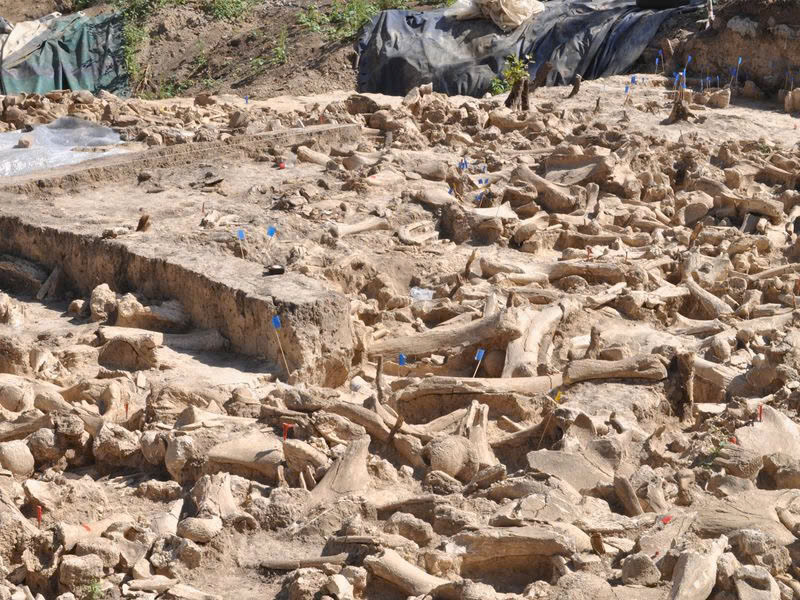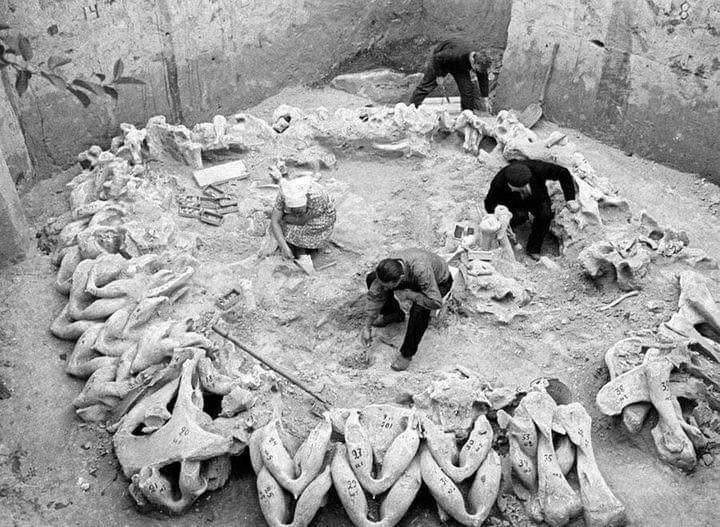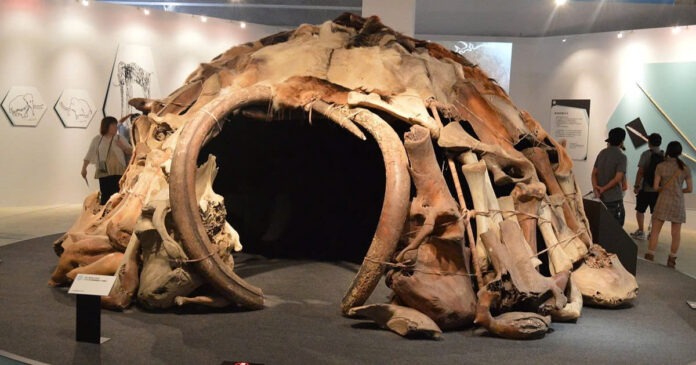The Mammoth Bone Huts of Mezherich: A 15,000-Year-Old Architectural Marvel
A Farmer’s Unexpected Discovery
In the spring of 1965, a Ukrainian farmer in the quiet village of Mezherich, near the banks of the Ros River, began digging to expand his basement. What he found beneath the soil would change the understanding of Ice Age life forever. His shovel struck something massive — not rock, but bone. As he cleared away the dirt, he uncovered the unmistakable curve of a mammoth jawbone.
What began as a simple home improvement project quickly became one of the most remarkable archaeological discoveries of the 20th century.
From Basement to Archaeological Wonder

When archaeologists arrived to examine the find, they realized the site was no random burial ground. Excavations revealed a complex structure composed of mammoth bones arranged with deliberate precision — the remains of prehistoric huts dating back roughly 15,000 years, built by humans who had mastered survival in one of Earth’s most unforgiving climates.
Over time, four distinct dwellings were uncovered. In total, they were built from the bones of at least 149 mammoths, including skulls, tusks, ribs, and femurs. These were not mere shelters — they were feats of Ice Age engineering.
Ice Age Ingenuity: Building with Bones
Adapting to a Harsh World

At the end of the last Ice Age, around 15,000 BCE, the environment of modern-day Ukraine was a windswept tundra. Wood was scarce, temperatures were brutal, and survival required both ingenuity and cooperation. The builders of Mezherich adapted by turning to the one resource readily available to them: the remains of the woolly mammoths that roamed the frozen plains.
The mammoth bone huts were arranged in circular patterns between four and six meters wide. Massive skulls formed the base, ribs created arch-like frameworks, and tusks supported the structure like curved beams. The exterior was likely covered with animal hides, transforming the bone frame into a well-insulated home capable of trapping warmth against the bitter cold.
Craftsmanship and Symbolism

Beyond their practicality, these huts also demonstrate the cognitive sophistication of their builders. The placement of the bones suggests planning, symmetry, and an understanding of stability and load-bearing — principles that foreshadowed architectural knowledge millennia ahead of its time.
Red ochre traces found on several bones suggest that these shelters were not purely functional; they may also have carried symbolic or ritual significance. For Ice Age communities, mammoths were more than prey — they were central to survival, myth, and identity.
A Window into Prehistoric Life
More Than Just Shelter
The Mezherich site revealed an astonishing array of artifacts within and around the huts — each a clue to the daily lives, beliefs, and connections of these early humans. Archaeologists uncovered tools fashioned from flint and bone, decorative ornaments, and even items hinting at long-distance exchange.
Art, Music, and Early Maps

Among the most striking discoveries were ornaments made of amber and seashells, materials that originated hundreds of kilometers away — clear evidence of trade or migration routes linking distant Ice Age communities.
Excavators also found a mammoth bone drum, painted with red ochre and possibly used in ceremonies or rituals. Even more extraordinary was an engraved bone that appears to depict a primitive map, possibly showing nearby rivers and hunting grounds. If confirmed, it could represent one of the earliest known examples of human cartography.
Together, these findings challenge long-held assumptions about Paleolithic people. Far from being mere hunters, they were artists, traders, musicians, and planners — capable of abstract thought and cultural expression.
The Legacy of Mezherich

The mammoth bone huts of Mezherich stand today as a testament to human resilience and innovation. They are among the oldest examples of architecture known to science, predating the invention of agriculture and permanent settlements by thousands of years.
The builders of Mezherich transformed the bones of Ice Age giants into homes that withstood Arctic winds and freezing nights — proof that creativity has always been humanity’s greatest survival tool.
A Continuing Source of Inspiration
Decades after their discovery, the Mezherich huts continue to captivate archaeologists, historians, and architects alike. Modern 3D reconstructions and climate studies of the site have deepened understanding of how early humans interacted with their environment, turning scarcity into opportunity.
In a world shaped by adaptation, the Mezherich site serves as a reminder that even in the harshest landscapes, human intelligence, collaboration, and imagination have always found ways to build — and to endure.
Sources
- Smithsonian Magazine – “The Ice Age Architects of Mezherich”
- National Geographic – “Prehistoric Homes Built from Mammoth Bones”
- Archaeology Magazine – “Life on the Mammoth Steppe”
- Journal of Human Evolution – “Structural Analysis of Mammoth Bone Dwellings in Eastern Europe”
